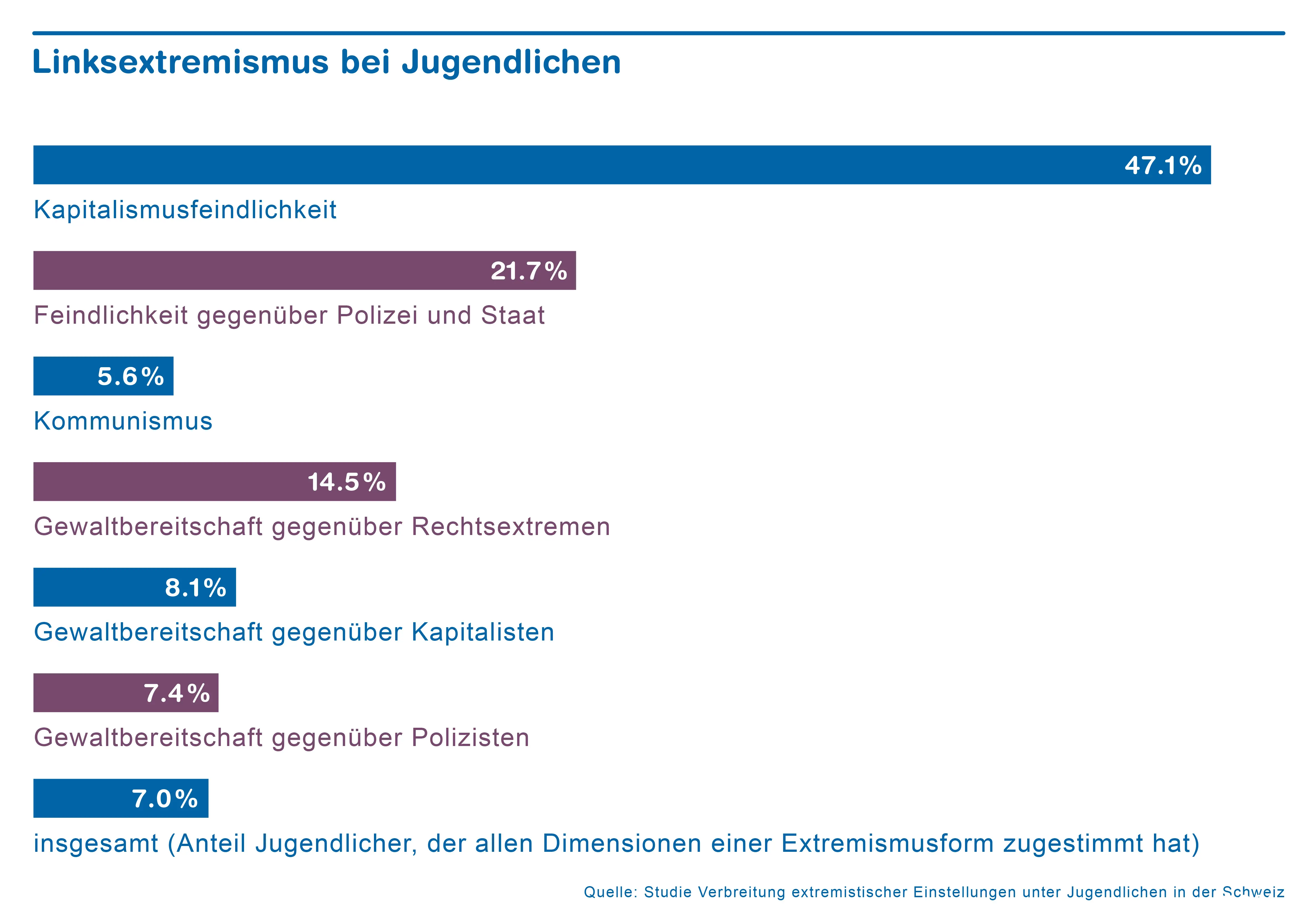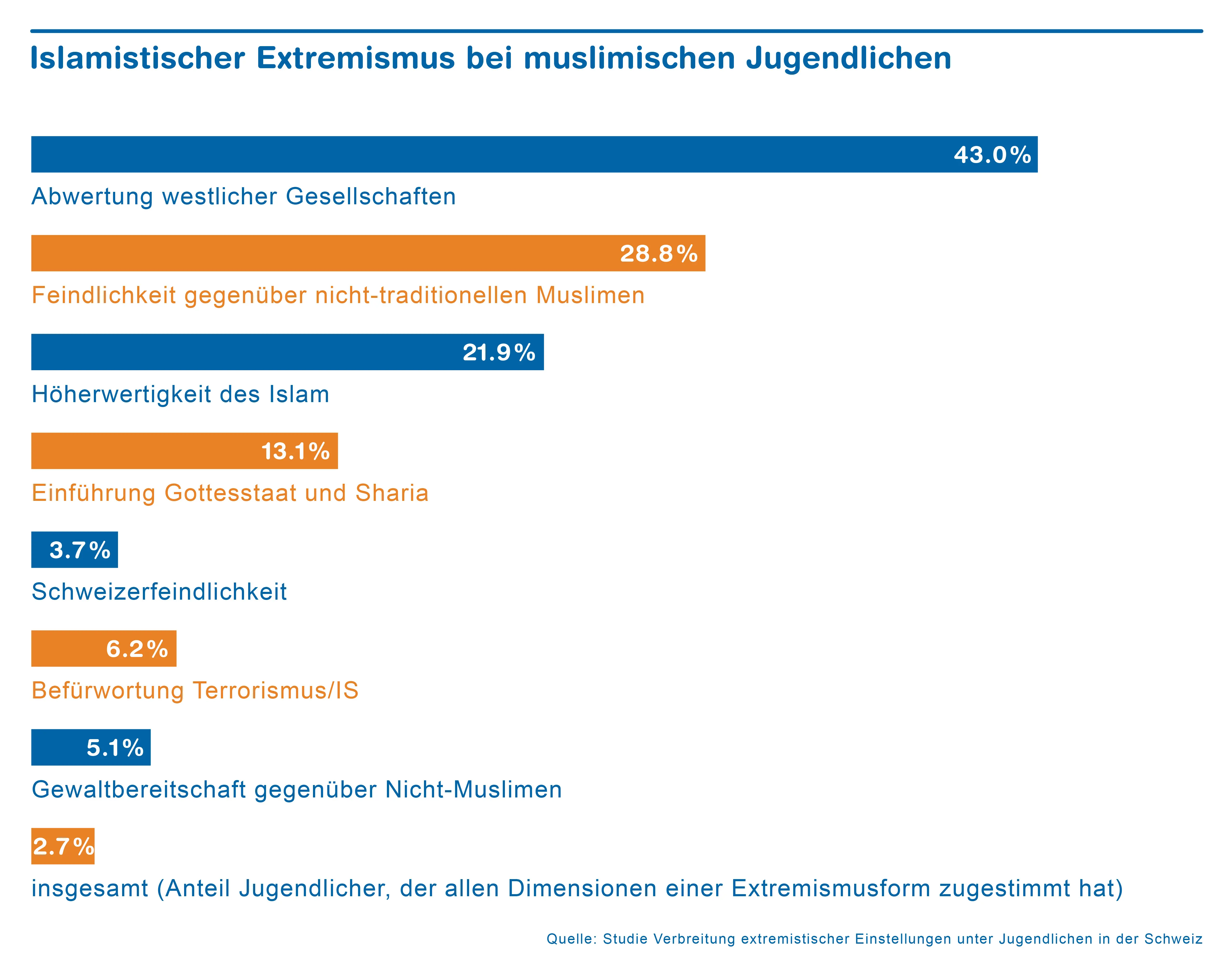Extremism among young adults: agreement with ideology is more widespread than propensity to violence
According to a study conducted by the ZHAW and the HETS-FR (Haute École de Travail Social Fribourg), young adults in Switzerland are more likely to agree with the ideologies of extremism than to be in favour of extremist violence. At 7 per cent, left-wing extremism is slightly more widespread than right-wing extremism. Only 2.7 per cent of Muslim young adults identify with Islamism.

Among young adults in Switzerland, agreement with the ideological aims of extremism is stronger than support for violence. In addition, agreement with extremism varies according to gender, type of school attended and social status: young male adults, young adults attending vocational schools or those from socially deprived backgrounds are more likely to have extremist views. Together with the Haute École de Travail Social Fribourg HETS-FR, the ZHAW has conducted a countrywide survey on the extent of right-wing extremism, left-wing extremism and Islamic extremism. Over 8000 young adults aged 17-18 from ten Swiss cantons took part in the survey, which was carried out in 2017. Political extremism was considered to comprise attitudes and behaviour which reject and aim to overturn the democratic state through violence. «Overall, the study showed that left-wing extremism is slightly more widespread then right-wing extremism», says ZHAW researcher and project leader Patrik Manzoni.
More left-wing than right-wing extremism
Among the young adults without a migration background who took part in the survey, 5.9 per cent identify with right-wing extremism. However, there are significant differences in their attitude towards the individual types of right-wing extremism: while about a quarter of young Swiss adults without a migration background (25.1 per cent) are inclined to xenophobia and about a fifth (21.1 per cent) to nationalism, only 4.8 per cent support violence against foreigners and only 5.4 per cent are in favour of a dictatorship. 2.6 per cent of the survey participants engaged in extreme right-wing behaviour involving violence in the last twelve months – this is understood as physical violence towards or damage to the property of foreigners or left-wing extremists.
Overall, 7.0 per cent of the survey participants identify with left-wing extremism. However, the differences in their attitude towards individual characteristics of left-wing extremism are even stronger than with right-wing extremism. Just under half (47.1 per cent) of the young adults identify as anti-capitalist and 21.7 per cent as hostile to the police and state. However, only 5.6 per cent are in favour of communism, and 8.1 per cent support violence against the police. In the past twelve months. 4.4 per cent displayed violent behaviour. This is understood to comprise damage to property in the name of anti-capitalism, attacks on police officers and physical violence towards and/or damage to the property of right-wing extremists.
Little hostility to Swiss
Of the Muslim young adults who took part in the survey, 2.7 per cent identified as extreme Islamists. Here again, there were differences in the degree of agreement with certain aspects of Islamic extremism. Just under half of the Muslim young adults (43 per cent) have a negative attitude towards Western societies. «Because, as they see it, Muslims are oppressed by the West and, in their eyes, exploitation by the Western world is responsible for violence and war in Islamic countries», says ZHAW researcher Dirk Baier, co-project leader. In addition, 28.8 per cent are hostile to non-traditional Muslims. In contrast, only 3.7 per cent of the Muslim young adults taking part in the survey expressed hostility to the Swiss and only 5.1 per cent a readiness to engage in violence against non-traditional Muslims.
Extremism varies according to type of school
In all forms of extremism covered by the survey, male young adults were more frequently represented than female. On the one hand, support for violence, which is regarded as a core factor in extremism, is significantly higher among male young adults. On the other, they also support the other attitudinal dimensions more frequently, although this is less apparent in the case of left-wing extremism and Islamic extremism. Attitudes towards all the forms of extremism also vary according to the type of school attended by the participants: vocational school students and those in transitional education programmes are more likely to support extremism than students at upper secondary specialised schools and baccalaureate schools. In the case of left-wing extremism, the differences are less pronounced than in the case of right-wing extremism. A lower social status – manifested by dependence on unemployment or welfare benefits – increases the likelihood of participants agreeing with extremist attitudes. However, this effect is not particularly strong. The same is true with regard to regional affiliation: although support for right-wing extremism is slightly higher in rural areas and support for left-wing extremism and Islamic extremism is slightly higher in urban areas, the differences are not very pronounced.
Downloads and further information
- Full report on the distribution of extremist attitudes among young adults in Switzerland (in German)
- Chart: Islamic extremism (in German)
- Chart: Left-wing extremism (in German)
- Chart: Right-wing extremism (in German)
- Project: Political Extremism among Young Adults in Switzerland: Extent and Influencing Factors
Contact
- Prof. Dr. Dirk Baier, Institute of Delinquency and Crime Prevention, ZHAW, Telephone 058 934 89 04, Email dirk.baier@zhaw.ch
- Dr. Patrik Manzoni, Institute of Delinquency and Crime Prevention, ZHAW, Telephone 058 934 88 71, Email patrik.manzoni@zhaw.ch
- Prof. Dr. Sandrine Haymoz, Haute École de Travail Social Fribourg, HETS-FR, Telephone 026 429 62 55, Email sandrine.haymoz@hefr.ch
- ZHAW Corporate Communications, Telephone 058 934 75 75, medien@zhaw.ch


